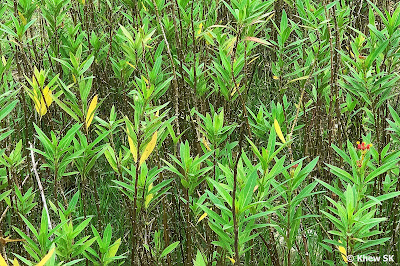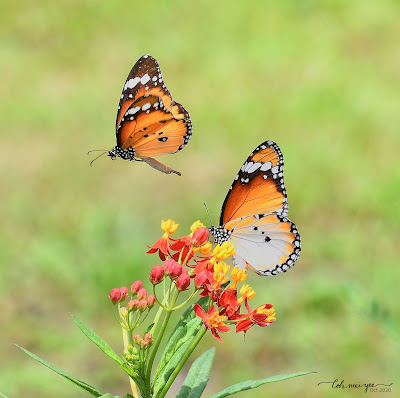Now You See Me, Now You Don't
A No-Brand (or Small) Grass Yellow (Eurema brigitta senna) feeding on the flower of the Coat Buttons (Tridax procumbens)
In an earlier blogpost about some butterfly species that have been documented as extant species historically, we featured some species that appeared over a period of time, when several pristine individuals were seen for several weeks. Then for some mysterious reason, they disappeared altogether and not seen for many years. They appeared in very localised areas in Singapore, and may even be temporarily common, but have not been seen since.
A Pitcher Blue (Virachola kessuma deliochus) perched on the fruit of the Singapore Rhododendron (Melastoma malabathricum)
In this weekend's blogpost, we take a look at three extant species that are relatively small in size, and unlikely to be migratory or stray species in the local environment. However, after appearing for a short period of time, two of these species have not been spotted for many years thereafter. Having been recorded by the early authors, these species were not reliably recorded for many decades, until the period between 2006 and 2009, when two of these species were observed in very localised areas in Singapore.
A White Fourline Blue (Nacaduba angusta kerriana) perched on a leaf in the forest understorey
Then they disappeared, and were not seen for many years since. It is not known where they disappeared to in the meantime. As they are not all forest-dependent species, where do they go to? Perhaps in some localised area where they have not been spotted yet? Or do they have some sort of hibernation mechanism in their life-history biology that allows them to delay eclosion for a long time?
A female No-Brand Grass Yellow ovipositing on its host plant. Cassia mimosoides
Interestingly, when they appeared in Singapore, all their life histories were recorded on their respective caterpillar host plants. Their life histories are documented here on this blog. From the records that are shown here, their early stages are quite normal and there is nothing out of the ordinary that suggests that they have special characteristics compared to other butterflies.
1. The No-Brand (or Small) Grass Yellow (Eurema brigitta senna)
A female No-Brand Grass Yellow feeding on the flower of the Coat Buttons
The No-Brand Grass Yellow (also called Small Grass Yellow) was a recorded as a re-discovery in 2006 when it was spotted at an open patch of land in Punggol that was cleared for future development. Its caterpillar host plant, Cassia mimosoides grew wild as a "weed" in the area. For a period of about up to a year or so, the species was quite common at that site, and mingled with many of the urban and scrubland butterfly species.
Today, a new public residential project is under construction at the site, and the open wasteland with secondary forest growth is no longer there. With that, the No-Brand Grass Yellow has disappeared. Efforts were made to cultivate its host plant in various places, and the caterpillars and pupae translocated to the other sites, but to no avail. The species has not been seen for a long time since then.
Upperside of the No-Brand Grass Yellow showing the scalloped black borders
A male No-Brand Grass Yellow perched on a leaf. Note the heavily-speckled wings
The species looks very similar to many of its other Eurema cousins that are common all over Singapore. The main different on the upperside is that the black borders are regularly scalloped, unlike the deeply excavated black borders of the other species. On the underside, there are no cell spots, and the wings are heavily peppered with brown freckles all over. The underside of the female is more distinctive in that the hindwing is a paler yellow than the forewing.
2. The White Fourline Blue (Nacaduba angusta kerriana)
A White Fourline Blue perched on a leaf
The next feature species is a small butterfly with a wingspan of only about 30-35mm. The White Fourline Blue was again, recorded as a re-discovery in 2009 at Telok Blangah Hill Park. It was a surprise as the species was documented as an extant species in Singapore by the early authors, but was not seen until 2009 - and even so, at an urban park. Was it one of the remnant species that survived despite the urban development in Singapore?
When it appeared, there were several individuals fluttering around the shaded shrubbery, and we even encountered a mating pair of the species, suggesting that there was a small, but critically-endangered colony in that location. Fortunately, our life histories expert, Horace Tan, spotted a female ovipositing on its host plant, Entada spiralis and managed to document its life history successfully.
Upperside of a newly-eclosed female White Fourline Blue
The male White Fourline Blue is purplish blue above with a thin black border. The female has a broad black border on the forewing, and a light blue to whitish ground colour with diffuse greyish markings on both wings. The female is so distinctive that it cannot be confused with any other species in the Nacaduba genus. The underside is greyish ground colour with broad white diffuse markings. There is a prominent black rounded submarginal spot in space 6 of the hindwing.
3. The Pitcher Blue (Virachola kessuma deliochus)
A Pitcher Blue perched on the flower of the Coat Buttons
Unlike the preceding two species, the Pitcher Blue is an extant rare species that was re-discovered in the early 1990's at a site near the nature reserves in Chestnut Forest. It was subsequently spotted at Kent Ridge Park and other areas in the Southern Ridges. It was only until it was again observed at Bukit Batok Forest that its life history was recorded.
The species depends solely on the caterpillar host plants from the Nepenthes genus - commonly called Pitcher Plants or Monkey Cups. These plants prefer hilltops and rather dry, rocky areas to grow. Today, these plants are not common (due to habitat destruction and poaching) and this has possibly affected the survival of the Pitcher Blue. That the caterpillars feed inside the seed pods of the Pitcher Plant makes it even harder to survive without the plant, and the fact that the plant has to flower and fruit as well!
Upperside of a female Pitcher Blue
Where are these species of butterflies today? Are they still lurking around somewhere, undiscovered, in some patch of greenery in our parks and nature reserves? Why have they disappeared for years on end? When will they reappear again? Answers to these questions continue to elude us as we strive on to struggle to further our knowledge and understanding of our butterflies to help conserve them for future generations.
Text by Khew SK : Photos by Khew SK and Horace Tan
Life Histories :



















































